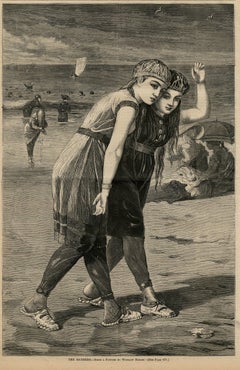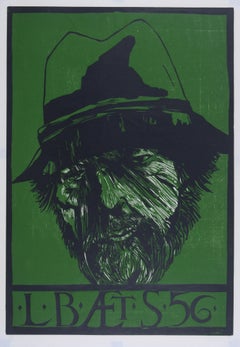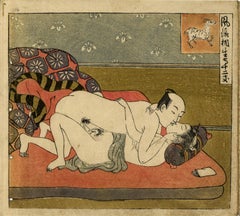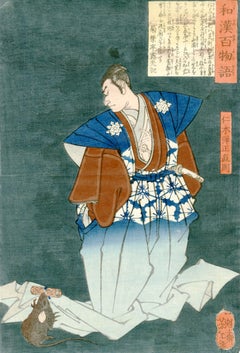Want more images or videos?
Request additional images or videos from the seller
1 of 8
Taiso YoshitoshiThe Ghost of Seigen Haunting Sakurahime1889
1889
$1,700List Price
About the Item
- Creator:Taiso Yoshitoshi (1839-1892, Japanese)
- Creation Year:1889
- Dimensions:Height: 14.38 in (36.53 cm)Width: 9.75 in (24.77 cm)
- Medium:
- Period:
- Condition:
- Gallery Location:Fairlawn, OH
- Reference Number:Seller: UK09001stDibs: LU14010551382
About the Seller
5.0
Recognized Seller
These prestigious sellers are industry leaders and represent the highest echelon for item quality and design.
Platinum Seller
Premium sellers with a 4.7+ rating and 24-hour response times
Established in 1978
1stDibs seller since 2013
813 sales on 1stDibs
Associations
International Fine Print Dealers Association
Authenticity Guarantee
In the unlikely event there’s an issue with an item’s authenticity, contact us within 1 year for a full refund. DetailsMoney-Back Guarantee
If your item is not as described, is damaged in transit, or does not arrive, contact us within 7 days for a full refund. Details24-Hour Cancellation
You have a 24-hour grace period in which to reconsider your purchase, with no questions asked.Vetted Professional Sellers
Our world-class sellers must adhere to strict standards for service and quality, maintaining the integrity of our listings.Price-Match Guarantee
If you find that a seller listed the same item for a lower price elsewhere, we’ll match it.Trusted Global Delivery
Our best-in-class carrier network provides specialized shipping options worldwide, including custom delivery.You May Also Like
Cultured Woman - Tokyo
By Art Hazelwood
Located in Palm Springs, CA
Signed and numbered color woodcut from the edition of 15. Modern woman in Tokyo; signed and titled edition of 15.
Art Hazelwood calls himself artist, instigator and impresario to define the three intertwining areas of his practice. He uses printmaking within a range of political allegory and satire making work from political posters to fine press edition artist books. He has curated and organized a range of exhibitions at venues from museums to immigrant centers. He has worked for over 20 years with homeless rights groups; creating prints, and street posters, and has authored one book and contributed to another on art and homelessness.
He has been a regular visiting guest artist at San Quentin State Prison and teaches currently at the San Francisco Art Institute. He organized the San Francisco Poster...
Category
2010s Contemporary Figurative Prints
Materials
Woodcut
Dilecti Mei Pulsantis
By Eric Gill
Located in London, GB
Original wood engraving, 1930-31, 14.6 x 6.7 cm. (5.7 x 2.6 in.)
Category
1920s Modern Figurative Prints
Materials
Woodcut
The Harem
By Eric Gill
Located in London, GB
Original wood engraving, 1925, on smooth cream wove paper, signed and numbered in pencil, sheet 32.2 x 25.4 cm. (16.7 x 10 in.)
The Harem was one of the original wood engravings designed by Eric Gill as illustrationsant series of prints, displaying every aspect of the striking yet graceful individual style for which Eric Gill is famed. for the Golden Cockerell Press edition of The Song of Songs, published in 1925. This overtly erotic engraving...
Category
1920s Modern Figurative Prints
Materials
Woodcut
"Poissonnerie" woodcut from the book "Petits métiers et gagne petit" by Foujita
By Léonard Tsugouharu Foujita
Located in Boca Raton, FL
"Poissonnerie" 1960 wood cut print by Léonard Tsugouhara Foujita from the book "Petits Métiers et gagne petit." Hand signed "Foujita" on front lower right corner. Hand numbered 12/60...
Category
1960s Other Art Style Figurative Prints
Materials
Woodcut
Toyohara Kunichika (1835-1900) - Woodblock, Kawacho Restaurant at Asakusa
By Toyohara Kunichika
Located in Corsham, GB
A charming Japanese woodblock print depicting three geishas playing instruments in a Kawacho restaurant. From Kaika sanjuroku kaiseki (Thirty-six famous restaurants and views of civi...
Category
Late 19th Century Figurative Prints
Materials
Woodcut
Toyohara Kunichika (1835-1900) - Japanese Woodblock, Kabuki Samurai I
By Toyohara Kunichika
Located in Corsham, GB
An evocative late 19th century Japanese woodblock by the master artist Toyohara Kunichika (1835-1900), depicting a Kabuki actor in the dramatic role of a fierce samurai. The composit...
Category
Late 19th Century Figurative Prints
Materials
Woodcut
Clare Leighton (1898-1989) - Signed Mid 20th Century Woodcut, Toulon Washerwomen
By Clare Leighton
Located in Corsham, GB
Washerwomen lean over a large tub, engaged in their labour in this fine woodcut by Clare Leighton (1898-1989), a rare signed example. Titled and signed in graphite below the image. N...
Category
20th Century Figurative Prints
Materials
Woodcut
Kunisada Utagawa (1786-1865) - Japanese Woodblock, Ladies in the Blossom
Located in Corsham, GB
A vibrant Japanese woodblock print by the prolific and prominent ukiyo-e artist Kunisada Utagawa (1786-1865) depicting two ladies in richly patterned traditional dress amongst blosso...
Category
Early 19th Century Figurative Prints
Materials
Woodcut
$450
H 19.3 in W 14.97 in
Yoshiiku Utagawa (1833-1904) - Japanese Woodblock, Geishas By The Oil Lamp
Located in Corsham, GB
A charming Japanese woodblock depicting two geishas in the light of an oil lamp. Unsigned. Presented in a contemporary black frame. On paper.
Category
Early 20th Century Figurative Prints
Materials
Woodcut
$450
H 17.33 in W 12.6 in
Clare Leighton (1898-1989) - 1935 Woodcut, Strawberry Picking
By Clare Leighton
Located in Corsham, GB
A charming woodcut by Clare Leighton from her 1935 book Four Hedges, which documents her experience creating a garden over the course of a year. Here, two women pick strawberries. Sm...
Category
Early 20th Century Figurative Prints
Materials
Woodcut
$595
H 10.63 in W 8.67 in
More From This Seller
View AllThe Bathers
By Winslow Homer
Located in Fairlawn, OH
The Bathers
Woodengraving, 1873
As published in Harper's Weekly, August 2, 1873 (p. 668)
Provenance:
Wunderlich & Co., Inc., New York, NY (Their stock no. 84.003.8 in pencil recto a...
Category
1870s American Realist Figurative Prints
Materials
Woodcut
Self Portrait-L.B. AET 56
By Leonard Baskin
Located in Fairlawn, OH
Self Portrait-L.B. AET 56
Color woodcut printed in black and green, 1978
Signed in pencil lower right (see photo)
Edition: 150 (97/150)
Condition: Excellent
Image: 32 x 22”
Sheet: 35...
Category
1970s American Modern Figurative Prints
Materials
Woodcut
Shunga: Twelve Signs of the Zodiac - Goat
Located in Fairlawn, OH
Shunga: Twelve Signs of the Zodiac - Goat
Color woodcut with gauffrage (embossing)
Unsigned (as usual)
Format: Shikishiban
Publisher: Privately produced
Unusually well preserved with the fugitive blue still intact
Image size: 5-1/8 x 5-3/4"
Sheet size: 5 3/8 x 6 1/4"
From Wikipedia, the free encyclopedia
In this Japanese name, the surname is Isoda.
Isoda Koryūsai (礒田 湖龍斎, 1735–1790) was a Japanese ukiyo-e print designer and painter active from 1769 to 1790.
Life and career
Koryūsai was born in 1735 and worked as a samurai in the service of the Tsuchiya clan. He became a masterless rōnin after the death of the head of the clan and moved to Edo (modern Tokyo) where he settled near Ryōgoku Bridge in the Yagenbori area. He became a print designer there under the art name Haruhiro in 1769, at first making samurai-themed designs. The ukiyo-e print master Harunobu died in 1770, and about that time Koryūsai began making prints in a similar style of life in the pleasure districts.
Koryūsai was a prolific designer of individual prints and print series,[1] most of which appeared between 1769 and 1881.
In 1782, Koryūsai applied for and received the Buddhist honour hokkyō ("Bridge of the Law") from the imperial court and thereafter used the title as part of his signature. His output slowed from this time, though he continued to design prints until his death in 1790.
Works
Koryūsai created a total of 2,500 known designs, or an average of four a week. According to art historian Allen Hockley, "Koryūsai may ... have been the most productive artist of the eighteenth century".
The series Models for Fashion: New Designs as Fresh Young Leaves (Hinagata wakana no hatsumoyō, 1776–1781) ran for 140 prints, the longest known ukiyo-e print series of beauties. He designed at least 350 hashira-e pillar prints, numerous kachō-e bird-and-flower prints, a great number of shunga erotic prints, and others. Ninety of his nikuhitsu-ga paintings are known, making him one of the most productive painters of the period.
Legacy
Despite Koryūsai's productivity and popularity—both in his time and amongst later collectors—his work has attracted little scholarship. The first ukiyo-e histories written in the West in the 19th century elevated certain artists as exemplars; Koryūsai's work came to be seen as too indebted to Harunobu, who died in 1770, and inferior to that of Kiyonaga, whose peak period came in the 1880s. An example is Woldemar von Seidlitz's Geschichte des japanischen Farbenholzschnittes ("History of Japanese colour prints", 1897), the most popular of the early ukiyo-e histories, which paints Koryūsai as a successor to Harunobu and a rival of Kiyonaga in the 1770s who slipped into mediocrity and imitation of his rival by the end of the decade.[5] Interest lay mainly in the details of Koryūsai's life—a samurai who received court honours was unusual in the proletarian world of ukiyo-e. In 2021, contemporary woodblock printmaker David Bull...
Category
1770s Other Art Style Figurative Prints
Materials
Woodcut
Nikki Danjo (Naonon)
By Taiso Yoshitoshi
Located in Fairlawn, OH
"One of the main characters of the kabuki play Meiboku Sendai hagi (The Disputed Succession)"
Signed: Ikkaisai Yoshitoshi ga (in gourd shaped cartouche)
Format: oban
Publisher: Da...
Category
1860s Figurative Prints
Materials
Woodcut
Plate 12
By Wassily Kandinsky
Located in Fairlawn, OH
Plate 12
From: 10 Origi, 1942
Signed in the block with the artist's initials lower left (printed)
From: 10 Origin
Not from the First edition 100, published by Allianz-Verlag, Zurich,...
Category
1970s Expressionist Abstract Prints
Materials
Woodcut
On the Beach at Long Branch - The Children's Hour
By Winslow Homer
Located in Fairlawn, OH
On the Beach at Long Branch - The Children's Hour
Wood engraving, 1874
Published in "Harper's Weekly" August 15, 1874 (p. 672)
Image size: 9 1/4 x 13 5/8 inches
Provenance: Wunderlic...
Category
1870s Hudson River School Figurative Prints
Materials
Woodcut
Recently Viewed
View AllMore Ways To Browse
Murakami Screen Print
Picasso Chevre
Raphael Soyer On Sale
Romero Britto On Sale
Salvador Dali 1968
Salvador Dali Woman
Signed Mr Brainwash
Vintage Crawling Baby
Woodblock Print Yoshitoshi
Aneta Szoltis Mencina
Aristide Bruant
Blanes Vintage
G Albert
Goya Los Desastres De La Guerra
Henri Lautrec Circus
Huckleberry Finn
Irreverent Art
Jesus Etching



